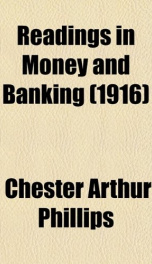readings in money and banking

Purchase of this book includes free trial access to www.million-books.com where you can read more than a million books for free. This is an OCR edition with typos. Excerpt from book: CHAPTER HI i QUALITIES OF THE MATERIAL OF MONEY 1 Many recent writers, such as Huskisson, MacCulloch, James Mill, Gamier, Chevalier, and Walras, have satisfactorily described the qualities which should be possessed by the ma- ter-ial of money. Earlier writers seem, however, to have understood the subject almost as well. . . . Of all writers, M. Chevalier . . .- probably gives the most accurate and full account of the properties which money should possess, and I shall in many points follow his views. The prevailing defect in the treatment of the subject is the failure to observe that money requires different properties as regards different functions. To decide upon the best material for money is thus a problem of great complexity, because we must take into account at once the relative importance of the several functions of money, the degree in which money is employed for each function, and the importance of each of the physical qualities of the substance with respect to each function. In a simple state of industry money is chiefly required to pass about between buyers and sellers. It should, then, be conveniently portable, divisible into pieces of various size, so that any sum may readily be made up, and easily distinguishable by its appearance, or by the design impressed upon it. When money, however, con1es to serve, as it will ,t some future time, almost exclusively as a measure and standard of value, the system of exchange, being one of perfected barter, such properties become a matter of comparative indifference, and stability of value, joined perhaps to portability, is the most important quality. Before venturing, however, to discuss such complex questions, we must proceed to a preliminary discussion of the properties in question, whichmay thus perhaps be enumerate...
Info about the book
Author:
Series:
Unknown
ISBN:
1172937990
Rating:
5/5 (6)Your rating:
0/5
Languge:
English
Users who have this book
Users who want this book
What readers are saying
What do you think? Write your own comment on this book!
write a commentif you like readings in money and banking try:
Other books by this author
Do you want to exchange books? It’s EASY!
Get registered and find other users who want to give their favourite books to good hands!


